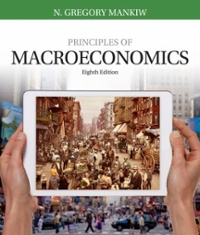Question
4. RBC Model Without Capital: Suppose the production function is given as Yt = AtN 1 t where At is the level of technology and
4. RBC Model Without Capital: Suppose the production function is given as Yt = AtN 1 t where At is the level of technology and Nt is labor. Households maximize utility of the following form: X s=0 s log (Ct) B N 1+ t 1 + ! subject to the budget constraint Ct + St = wtNt + (1 + rt)St1 + t(1 t) where t are profits and 0 < t < 1 is the tax rate on profits. Firms maximize profits given by t = Yt wtNt = AtN 1 t wtNt . The government uses the tax proceeds to finance some spending and the budget is balanced each period: Gt = tt 3 The goods market clears, so that Ct + Gt = Yt and St = 0 in equilibrium (there is no capital!). Both, labor and goods markets are assumed to be competitive. Denote by gt = Gt Yt the ratio of government spending to output. Each period, the government decides on gt and adjusts tax rates to balance the budget. (a) Write the first-order conditions characterizing the optimal demand for labor by the firm and the optimal choice of labor supply by the household. (b) Compute the equlibrium employment, consumption, output and the real wage as a function of At , gt and other model parameters. (c) How does an increase in At(holding gt constant) affect employment, consumption, output and the real wage? (d) How does an increase in gt (holding At constant) affect employment, consumption, output and the real wage?
Step by Step Solution
There are 3 Steps involved in it
Step: 1

Get Instant Access to Expert-Tailored Solutions
See step-by-step solutions with expert insights and AI powered tools for academic success
Step: 2

Step: 3

Ace Your Homework with AI
Get the answers you need in no time with our AI-driven, step-by-step assistance
Get Started


